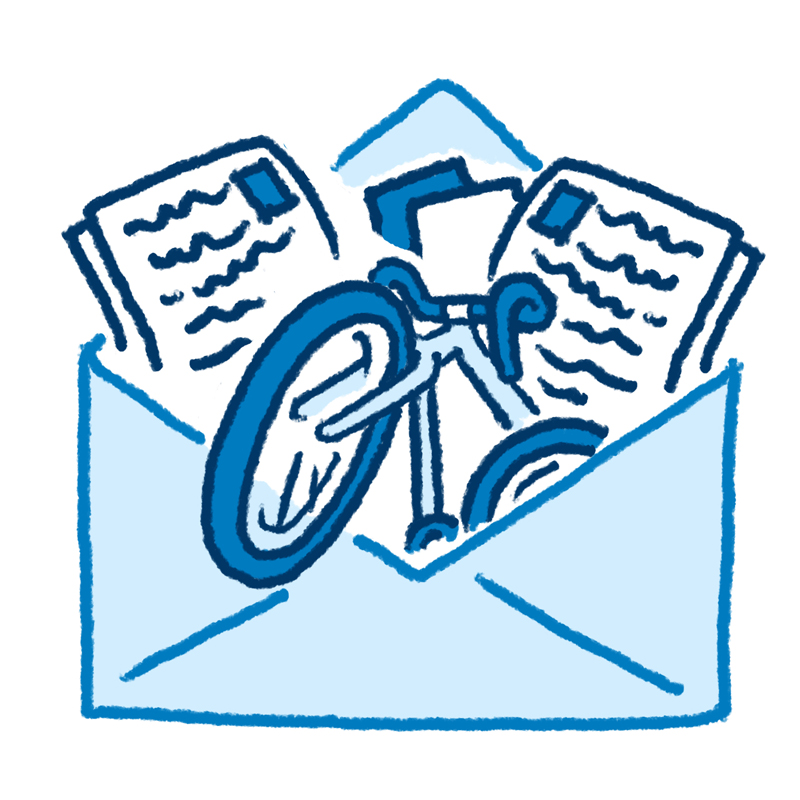Bikepacking Gear: What to Take & How to Pack It
If bike touring with panniers is like traveling with a big roller suitcase, bikepacking is like traveling with only a carry-on backpack. The goal is to have everything you need and also to need everything you have.
Here are some tips for packing lighter:
- Bring less stuff! Ask yourself “What would happen if I didn’t bring this?” If the answer is unremarkable, then leave it at home.
- Repackage consumables like toiletries, food, and chain lube into smaller containers and remove extra packaging.
- Don’t sweat personal hygiene. Though it’s smart to keep saddle-related areas clean to avoid chafing or infection, it’s normal to let other standards slip a bit.
- Use gear for multiple purposes: eat directly out of your pot, sleep with your head on a stuff sack full of clothes, use a spare sock as a camp towel, and dig your bathroom cathole with a tent stake.
- Look to the lightweight (or even ultralight) backpacking community for more ideas.
Clothing for Bikepacking
You don’t need a whole new wardrobe for bikepacking, but there are a few important points to consider when planning a clothing system that’s both effective and lightweight.
- Base layers: this is what you’ll be riding in when the weather is warm. Choose fabrics that dry fast and pull moisture away from your skin. Avoid cotton in favor of synthetics or merino wool.
- Mid layers: long sleeve shirt and tights for extra warmth and/or sleeping.
- Insulated jacket: for evenings and chilly mornings, or to sleep in on cold nights. High quality down is the warmest and lightest, but synthetic or fleece can also work.
- Rain protection: waterproof breathable rain jacket and pants, and perhaps waterproof shoe covers. Rain gear also takes the edge off wind-chill on cold descents.
- Extras: gloves, warm hat or hood, and warm socks for sleeping.
You won’t always need all this clothing. Everyone has a different threshold, but daily lows below 50 degrees Fahrenheit signal a need to think carefully about warmth, and any chance of rain becomes more serious when temperatures are cold.
Camping Gear
Camping gear can seem like a big topic, but it doesn’t have to be overwhelming. If you already have backpacking gear in your garage you’re most of the way there, and if not, just a few essentials will get you started.
- As with bikepacking bags, eBay and Craigslist are good places to find deals on quality used backpacking gear. You could also try borrowing from friends who may have a tent or sleeping bag sitting in their garage, or asking your riding partners if they have any extra gear to share.
- Tent or other shelter: A lightweight tent that is freestanding is ideal for bikepacking because it can be pitched anywhere, even on rocky ground or concrete. Tarps are lighter but limit potential camping locations, as do hammocks. Bivvy sacks are lightest but offer less privacy and space and tend to collect condensation.
- Sleeping bag or quilt: A quality down sleeping bag — or even better, its lightweight cousin the sleeping quilt — will serve you well on outdoor adventures of all kinds. Synthetic insulation is cheaper than down, but heavier and less compact for the same warmth.
- Sleeping pad: Accordion-fold backpacking pads work better than you might expect for bikepacking. They’re cheap and lightweight, and while they definitely won’t fit in your saddle bag, they strap easily to its top, or to your handlebars. If you need more comfort and/or warmth, look to lightweight inflatable pads.
- Cooking system: Check resupply options carefully before packing a bulky cook system. If you’ll be passing a town once every day or two it’s easy to fuel with grab-and-go town food and no-cook staples like cold ramen or cheese and salami. If you can’t resupply often or require hot coffee in the morning, consider a compact alcohol stove which doesn’t require a bulky fuel canister.
Water: Carrying and Purifying
Water is important and heavy, so consider it carefully when planning your gear setup. The amount of water capacity you’ll need depends on weather, route, riding speed, and whether you’ll be sleeping near water sources or dry camping.
A good rule of thumb for routes with plentiful water is to carry about two liters at a time and refill as needed. On hot days or with no refill opportunities, carry at least four liters. If you can’t count on water at camp, five to six liters will last most people through a day of riding and night of dry camping, but you won’t have much extra for washing your body or dishes at camp. In very hot weather or dry landscapes, it’s not unheard of to carry 10 liters or more!
At 2.2 pounds per liter, it’s the heaviest thing you’ll be carrying. Common places include a hydration bladder in a frame bag or backpack, and bottles mounted to the front fork or down tube. In dry areas you might need to use several methods at once.
Always filter or purify water from natural sources to avoid getting sick from waterborne pathogens. A lightweight backpacking filter like the Sawyer Squeeze catches bacteria and parasites, which is sufficient in the US and other infrastructure-rich countries. In places where sanitation infrastructure is lacking, you’ll want a purification method — like UV radiation or chlorine dioxide drops — that deactivates viruses too.
Electronics and Charging
If you’re using a smartphone as a navigation device, route notes, camera, journal, and occasional music player, it’s going to run through batteries like there’s no tomorrow. And that doesn’t include your satellite messenger, bike lights, and headlamp! If your route includes plentiful wild camping and few town stops, keeping all these devices charged is a challenge.
Fortunately portable USB power banks keep getting smaller, lighter, and cheaper. One 10,000mAh power bank can charge a smartphone several times. To stretch your power supply further, keep smartphones in airplane mode and the screen dimmed or off as much as possible.
For very remote trips with no resupply options, on-the-go charging might be necessary. Dynamo hubs, the best but priciest option, generate power from the front wheel. Portable solar chargers are far cheaper and getting more efficient but can be awkward to attach to a bikepacking bag setup.
One thing you may not be using your smartphone for while bikepacking: communication. Especially in the western US, it’s common to be out of cell service range for most or all of a trip. Many people carry a satellite messaging device like a SPOT or Garmin InReach, which can contact emergency services even from remote places.
Gear Essentials Checklist
With experience you’ll develop your own packing list, but here’s a basic one to get you started. Expect to make adaptations for your trip’s climate, style, length, and your own preferences. Most people have a luxury item or two that are worth the weight but we suggest packing all the essentials first before deciding how much luxury to indulge in.
Clothing for Riding
- Bike shorts (1-2 pair)
- Shirt (1-2, lightweight merino wool is smell-resistant)
- Underwear (1-2)
- Socks (2 pairs)
- Buff or bandana
- Sun sleeves or long-sleeve shirt for sun protection
- Clothing for Cold, Rain, and Sleeping
- Tights or long underwear
- Long sleeve midlayer shirt
- Puffy jacket
- Waterproof breathable rain jacket
- Rain pants
- Waterproof shoe covers
- Warm gloves
- Waterproof mittens
- Warm hat or hood
Cycling Accessories
- Shoes to bike and walk in
- Bike gloves
- Helmet
- Helmet mirror (helpful if route includes any busy roads)
- Tail light
- Head light (even if you don’t plan to ride at night)
- High visibility flag or vest (for routes with busy roads)
- Lightweight bike lock (depending on route)
Electronics
- Navigation device
- Charging cables and wall charger
- Power bank(s)
- Satellite emergency messenger like SPOT or Garmin InReach (if desired)
- Spare batteries
Water and Food
- Hydration bladder(s) and/or bottle(s)
- Water filter or purification method
- Bowl and spoon or spork
- Stove, fuel, and pot (optional, depends on route)
- Bag and cord for animal-safe food storage (where needed)
Camping
- Shelter
- Sleeping bag or quilt
- Sleeping pad
- Headlamp
Miscellaneous
- Sunglasses
- Sunscreen
- Chapstick with sunblock
- Chamois cream (as needed)
- Bug repellent (as needed)
- Toiletries (minimal and repackaged into small containers)
- Toilet paper, and plastic bag to pack out used
- Hand sanitizer
- Biodegradable soap in small bottle and/or hygiene wipes
- Ziplock bags or dry sacks in various sizes
- Lightweight sandals
- Maps and route notes
- Wallet with ID, and cash in small denominations for campgrounds if needed
Safety
- Small first aid kit
- Metallic space blanket (for emergencies or to supplement sleeping bag in cold weather)
- Lighter and fire starter (for cooking or emergencies)
- Bear spray (only in grizzly areas)
Tools and Spare Parts
- Chain lube (in small bottle) and rag
- Bike multitool with chain breaker
- Tire levers
- Spare tube(s)
- Patch kit
- Tire boot
- Extra sealant (if tubeless)
- Tire repair plugs (if tubeless)
- Blue Loctite for loose bolts
- Spare cleat and blots (if using SPD shoes)
- Chain masterlinks and masterlink pliers
- Leatherman with pliers and knife
- Zip ties
- Tape (duct, gorilla, electrical) — wrap a few turns around a lighter or part of frame
- Depending on trip length, bike, remoteness, etc:
- Spare brake and shift cables
- Spare brake pads
- Spare section of chain
- Spare spokes
- Extra straps for gear failure or on-the-fly luggage rearranging
- Needle and strong thread or dental floss for tire repair (if tubeless)
The Packing Puzzle
It’s finally time! You’re staring at a bicycle, a collection of bags, and a pile of gear and wondering how on earth it’s all going to fit together.
- Do a practice pack well in advance. The night before your trip is a bad time to realize your sleeping quilt doesn’t fit in your handlebar bag without blocking your shift levers.
- After your practice pack, take a practice ride. Notice how your loaded bike handles and whether that overstuffed frame bag grazes your knees. Even better, practice your packing and camping setup too: ride to a friend’s house and camp in their backyard.
- Pack heavy things low and close to the middle of the bike to keep it handling nimbly. The frame bag, down tube, and front fork are best for heavy things like water, tools, and electronics.
- Pack items you’ll need during the day in easy-to-reach places, and bury things you won’t need until camp.
- Remove stuff sacks and compress soft gear and clothing directly into every nook and cranny of your bikepacking bags.
- Waterproof key gear like electronics, warm layers, and your sleeping bag. Many bikepacking bags are supposedly waterproof, but if in doubt, line them with a kitchen trash bag and enclose electronics in ziplock baggies.
- Can’t find the right place for a bulky tent? Split it into pieces, strapping poles to your downtube and stuffing the rest into a seat bag or handlebar bag.
- Arrange your “cockpit” for convenience, including easy access to on-the-go snacks. If your handlebar bag leaves no space for a bike computer, light, or other handlebar-mounted gizmos, consider a bar extender.
- Rough trails have a way of separating gear from bikes. If you attach items like stuff sacks, camp shoes, or a jacket to the outside of your bags, be sure to tether them securely if you want to see them again. And secure all buckles or straps.
Next up: Training for Your Bikepacking Trip


